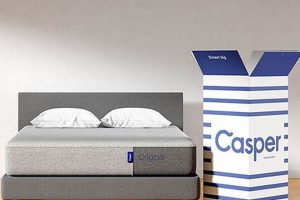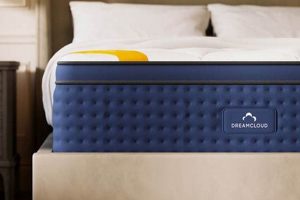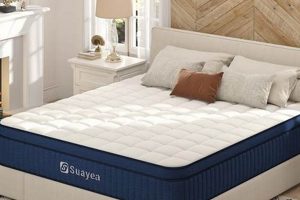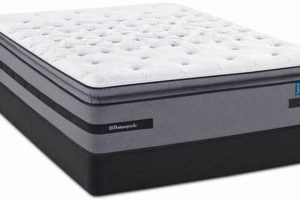A sleep system consisting of a large-sized mattress, measuring approximately 76 inches wide and 80 inches long, paired with a motorized foundation that allows for customized positioning. This system permits users to elevate the head and/or foot of the bed, providing variations in sleeping and resting postures.
This combination provides enhanced comfort and support, potentially alleviating pressure points and improving circulation. Historically, adjustable beds were primarily utilized in healthcare settings; however, increasing consumer demand for personalized comfort and lifestyle enhancements has driven their adoption in residential environments. The integration of a larger mattress size further caters to individuals seeking ample space and freedom of movement during sleep.
The subsequent sections will explore the specific advantages, available features, selection criteria, and practical considerations associated with choosing such a system. These factors will enable informed decision-making when considering an upgrade to one’s sleep environment.
Key Considerations for Optimal Selection
The following guidelines assist in making informed decisions regarding the acquisition and utilization of such sleep systems.
Tip 1: Assess Individual Needs: Prior to purchase, identify specific requirements, such as back pain relief, improved circulation, or enhanced comfort for activities like reading or watching television in bed. The adjustment capabilities should directly address these needs.
Tip 2: Evaluate Mattress Compatibility: Ensure the chosen mattress is compatible with the adjustable base’s articulation. Memory foam and latex mattresses typically offer greater flexibility and conformability compared to innerspring models. Verify manufacturer recommendations regarding suitable mattress types.
Tip 3: Scrutinize Base Features: Investigate the base’s range of motion, motor quality, and noise level. Features such as pre-set positions, massage functions, and under-bed lighting may enhance the overall experience. A robust motor with a warranty ensures longevity.
Tip 4: Consider Room Dimensions: Account for the overall footprint of the system, including clearance for movement around the bed. Ensure sufficient space is available to accommodate the adjusted positions without obstructing doorways or other furniture.
Tip 5: Research Warranty and Return Policies: Thoroughly review the warranty terms for both the mattress and the adjustable base. Understand the procedures for returns, repairs, and replacements. A comprehensive warranty provides protection against potential defects or malfunctions.
Tip 6: Verify Weight Capacity: Confirm the base’s maximum weight capacity to ensure it can safely and reliably support all occupants and the mattress. Exceeding the weight limit can damage the base and void the warranty.
Careful consideration of these factors will facilitate the selection of a system that aligns with individual needs and preferences, resulting in improved sleep quality and overall well-being.
The subsequent section will provide a concluding summary of the key aspects discussed throughout this article.
1. Size and Dimensions
The expansive dimensions of a king mattress, typically measuring 76 inches in width and 80 inches in length, constitute a foundational aspect when paired with an adjustable base. These measurements directly influence the spatial requirements within the bedroom environment and the system’s capacity to accommodate multiple occupants comfortably. The increased width provides ample space for couples, minimizing sleep disturbance caused by movement. Moreover, the fixed length ensures sufficient support for taller individuals, promoting proper spinal alignment.
The dimensions of the adjustable base itself introduce further considerations. The base’s articulation mechanisms and motor housing contribute to its overall footprint, potentially extending beyond the mattress dimensions when fully adjusted. This extension necessitates careful planning of room layout to prevent obstruction of pathways or interference with adjacent furniture. For instance, a fully inclined base may require additional clearance behind the headboard. Failure to account for these extended dimensions can result in functional limitations and compromise the intended benefits of the adjustable system. Further, The “split king” configuration, where two twin XL mattresses are placed side by side on an adjustable base, creates independent adjustability that is essential for couples with drastically different sleeping habits or requirements. This also changes the considerations of size and dimension.
In summary, the size and dimensions of both the king mattress and the adjustable base are paramount considerations. They directly impact spatial planning, occupant comfort, and the overall functionality of the sleep system. A thorough understanding of these dimensional factors ensures a harmonious integration of the system within the bedroom environment, maximizing its intended benefits and minimizing potential drawbacks. The physical constraints of the room and the user’s expectations regarding comfort and movement must be considered during the selection process.
2. Mattress Compatibility
Mattress compatibility is a crucial determinant of performance and longevity when integrating a king mattress with an adjustable base. The interaction between these components directly affects the system’s ability to provide optimal support, conformability, and durability. Mismatched components can compromise functionality and reduce the lifespan of both the mattress and the base.
- Flexibility and Conformability
Mattresses must possess sufficient flexibility to conform to the adjustable base’s contours without damage or distortion. Materials like memory foam and latex generally exhibit superior conformability compared to traditional innerspring mattresses. Incompatible innerspring mattresses can experience coil damage or reduced support when repeatedly bent at unnatural angles. This consideration is essential, as improper flexing can lead to premature wear and tear and a decline in sleep quality. Consider mattresses that specifically indicate adjustable base compatibility.
- Thickness and Weight
Mattress thickness and weight must be within the adjustable base’s specified parameters. An excessively thick or heavy mattress may strain the base’s motor and articulation mechanisms, potentially leading to premature failure. Conversely, a too-thin mattress may not provide adequate cushioning or support when used with the base’s various adjustable positions. The base manufacturer’s recommendations regarding optimal mattress weight and thickness should be strictly adhered to.
- Material Composition and Durability
The mattress’s material composition impacts its long-term durability when subjected to the stresses of an adjustable base. Hybrid mattresses, combining innerspring coils with foam layers, can offer a balance of support and flexibility, provided the coil system is designed for adjustable base compatibility. Mattresses with reinforced edges often provide enhanced structural integrity, preventing sagging or deformation along the perimeter. A thorough assessment of the mattress’s construction is vital to ensure its resilience under the demands of an adjustable system.
- Warranty Considerations
Using an incompatible mattress with an adjustable base may void the warranties of either or both products. Manufacturers often stipulate that mattresses must meet specific criteria to be covered under warranty when used with adjustable bases. Carefully review the warranty terms and conditions for both the mattress and the base to ensure compliance and protect against potential financial losses in case of defects or malfunctions.
In summary, the selection of a compatible mattress is paramount for maximizing the benefits and extending the lifespan of a king mattress with an adjustable base. Factors such as flexibility, weight, material composition, and warranty considerations must be carefully evaluated. Adherence to manufacturer recommendations and a thorough understanding of these compatibility factors will ensure a harmonious and durable sleep system.
3. Adjustability Range
The adjustability range of a king mattress with an adjustable base directly dictates the system’s functional versatility and its capacity to cater to diverse user needs. A limited range restricts the potential for customized comfort, potentially negating the core benefits of an adjustable system. Conversely, an expansive range enables a broader spectrum of positions, accommodating activities such as reading, watching television, or alleviating specific medical conditions. For example, individuals with acid reflux may benefit from a significant head elevation, while those with lower back pain might require subtle adjustments to the lumbar region. The adjustability range therefore directly impacts the system’s effectiveness in addressing these specific needs.
The available range is often quantified by the maximum degree of inclination attainable at both the head and foot sections of the base. While a higher degree may seem inherently superior, the practical relevance depends on the individual user’s requirements. Excessive inclination may induce discomfort or strain in certain users. Furthermore, the smoothness and precision of the adjustment mechanism are critical. Abrupt or jerky movements can disrupt sleep and diminish the overall experience. Bases with pre-set positions offer convenience and repeatability, allowing users to quickly return to preferred configurations. Systems incorporating memory functions further enhance usability by storing personalized settings for multiple users. For instance, a couple may each have unique preferred positions for reading and sleeping, which can be easily recalled at the touch of a button.
In summary, the adjustability range represents a fundamental characteristic of a king mattress with an adjustable base, influencing its overall utility and user satisfaction. The optimal range is contingent upon individual needs and preferences, encompassing considerations of both degree of inclination and the sophistication of the adjustment mechanism. A comprehensive understanding of these factors enables informed decision-making, ensuring that the selected system effectively addresses the user’s specific requirements and promotes enhanced comfort and well-being. A limited range can negatively impact the user experience and fail to deliver the intended benefits, while an overly expansive range may prove impractical or even detrimental.
4. Motor Durability
The operational lifespan and reliability of a king mattress with an adjustable base are intrinsically linked to the durability of its motor system. The motor’s primary function is to facilitate the articulation of the base, enabling adjustments to the head and foot sections. Frequent and sustained use places considerable strain on the motor, making its robust construction and operational efficiency paramount. A substandard motor is susceptible to premature failure, resulting in functional impairment of the adjustable base and necessitating costly repairs or replacements. The cause-and-effect relationship is direct: compromised motor durability leads to reduced functionality and increased maintenance burdens.
The motor serves as the core component responsible for converting electrical energy into mechanical motion, thereby enabling the user to attain personalized comfort positions. Real-life examples highlight the significance of this component. A family with a member suffering from sleep apnea relies on the adjustable base to elevate the head, promoting unobstructed breathing. Motor failure in such a scenario can disrupt sleep and negatively impact health. Similarly, elderly individuals with mobility limitations depend on the adjustable base for ease of ingress and egress from the bed. A durable motor is essential for maintaining their independence and safety. The practical significance of understanding motor durability lies in making informed purchasing decisions. Consumers should prioritize models with robust motor designs, often indicated by extended warranties and verifiable performance specifications.
In conclusion, motor durability is a non-negotiable factor when evaluating a king mattress with an adjustable base. Its impact extends beyond mere convenience, affecting the system’s long-term functionality, cost-effectiveness, and the user’s overall well-being. Neglecting this aspect can lead to frustration, financial burden, and compromised health outcomes. Therefore, thorough research and a discerning selection process are crucial to ensure a durable and reliable sleep experience. The challenge lies in discerning verifiable performance specifications from marketing claims, requiring consumers to seek out independent reviews and consult with knowledgeable retailers.
5. User Comfort
User comfort is a primary determinant of satisfaction with a king mattress and adjustable base system. The adjustable base offers personalized positioning, theoretically enhancing comfort beyond that of a static bed frame. However, the degree to which this potential is realized depends on several factors, including mattress compatibility, range of adjustability, and the user’s individual physiological needs. An ill-suited mattress may negate the benefits of the adjustable base, leading to discomfort or even exacerbating existing physical issues. For example, a mattress that is too firm may not conform adequately to the adjusted positions, creating pressure points and hindering restful sleep.
The practical significance of user comfort manifests in various real-life scenarios. Individuals with chronic back pain may find that specific inclines or elevations significantly alleviate pressure on the spine, allowing for improved sleep quality. Similarly, those with respiratory conditions such as sleep apnea or acid reflux may experience symptom relief by
elevating the head of the bed. User comfort is also paramount for individuals who spend extended periods in bed due to illness or mobility limitations. In these cases, the adjustable base allows for frequent repositioning, preventing pressure sores and promoting circulation. The importance of comfort is underscored by the prevalence of adjustable beds in healthcare settings, where patient well-being is the top priority.
Ultimately, the connection between user comfort and a king mattress with an adjustable base is symbiotic. The adjustable base provides the mechanical means to customize sleep positions, while the mattress provides the supportive and cushioning surface. The challenge lies in selecting components that are mutually compatible and tailored to the user’s individual needs. A holistic approach, encompassing factors such as physical condition, sleep habits, and personal preferences, is essential to maximizing comfort and achieving the intended benefits of this sleep system. Therefore, a pre-purchase trial, whenever feasible, is a valuable means of assessing the comfort levels afforded by a specific combination of mattress and adjustable base.
6. Long-term Health
The long-term impact on health represents a critical consideration when evaluating the suitability of a king mattress with an adjustable base. The sleep environment exerts a significant influence on physical and mental well-being, and the features of this system can either promote or detract from long-term health outcomes. A thorough understanding of these connections is essential for informed decision-making.
- Spinal Alignment and Musculoskeletal Health
Prolonged misalignment of the spine during sleep can contribute to chronic back pain, neck stiffness, and other musculoskeletal issues. An adjustable base allows for customized positioning that can promote proper spinal alignment, reducing strain on joints and muscles. For instance, individuals with scoliosis or kyphosis may benefit from specific adjustments that provide targeted support. This personalized support can help prevent the development or progression of these conditions over time.
- Circulatory Health and Edema Management
Impaired circulation during sleep can lead to various health complications, including edema, varicose veins, and an increased risk of blood clots. Elevating the legs with an adjustable base can improve venous return, reducing swelling and discomfort. This is particularly beneficial for individuals with circulatory disorders or those who spend extended periods sitting or standing. Improved circulation can also contribute to better cardiovascular health overall.
- Respiratory Function and Sleep Apnea Mitigation
Obstructive sleep apnea, a condition characterized by repeated interruptions of breathing during sleep, can have serious long-term health consequences, including increased risk of heart disease, stroke, and diabetes. Elevating the head with an adjustable base can help keep airways open, reducing the severity of sleep apnea episodes. This can lead to improved sleep quality and a reduced risk of associated health complications.
- Acid Reflux and Gastrointestinal Comfort
Nocturnal acid reflux can disrupt sleep and damage the esophagus over time. Elevating the head of the bed with an adjustable base can help prevent stomach acid from flowing back into the esophagus, reducing discomfort and minimizing the risk of long-term complications such as Barrett’s esophagus. This simple adjustment can significantly improve gastrointestinal health and sleep quality.
These facets demonstrate the significant potential of a king mattress with an adjustable base to positively impact long-term health. By providing personalized support and promoting optimal physiological function during sleep, this system can contribute to improved musculoskeletal health, circulatory function, respiratory capacity, and gastrointestinal comfort. However, it is crucial to select components that are tailored to individual needs and to consult with healthcare professionals to determine the most appropriate adjustments for specific health conditions. Furthermore, maintaining a healthy lifestyle, including regular exercise and a balanced diet, is essential for maximizing the long-term health benefits of this sleep system.
Frequently Asked Questions
The following addresses common inquiries regarding king mattresses with adjustable bases. This information is intended to provide clarity and aid in informed decision-making.
Question 1: What are the standard dimensions of a king mattress intended for use with an adjustable base?
The standard dimensions for a king mattress are approximately 76 inches in width and 80 inches in length. It is imperative to verify that the dimensions are compatible with the selected adjustable base to ensure proper fit and functionality.
Question 2: Which mattress types are generally recommended for use with adjustable bases?
Memory foam, latex, and certain hybrid mattresses are typically recommended due to their flexibility and ability to conform to the contours of the adjustable base. Innerspring mattresses may not be suitable, as they may lack the necessary flexibility and could be damaged by the articulation of the base.
Question 3: What is the typical range of adjustability offered by adjustable bases?
The range of adjustability varies depending on the model but generally includes independent adjustments for the head and foot sections. The degree of inclination can range from a few degrees to nearly vertical, allowing for customized positioning.
Question 4: What factors should be considered when evaluating the motor durability of an adjustable base?
Consider the motor’s warranty, noise level, and weight capacity. A longer warranty typically indicates greater confidence in the motor’s longevity. The motor should operate quietly to minimize sleep disturbance. The weight capacity should be sufficient to support the mattress and all occupants.
Question 5: How does an adjustable base contribute to user comfort and potential health benefits?
An adjustable base allows for customized positioning, which can alleviate pressure points, improve circulation, and provide relief from certain medical conditions such as acid reflux, sleep apnea, and back pain. It also facilitates activities such as reading or watching television in bed.
Question 6: What warranty considerations are relevant when purchasing a king mattress with an adjustable base?
Carefully review the warranty terms for both the mattress and the adjustable base. Ensure that the warranty covers potential defects in materials and workmanship. Also, verify that using a particular mattress with the adjustable base will not void the warranty for either product.
In summary, informed purchasing decisions require a thorough understanding of dimensions, mattress compatibility, adjustability range, motor durability, comfort and health benefits, and warranty considerations.
The subsequent section will provide a concluding overview of the key aspects discussed throughout this article.
Conclusion
This exploration of the king mattress with adjustable base has illuminated critical factors influencing the selection, utilization, and long-term implications of such a sleep system. Key considerations span dimensional compatibility, mattress suitability, adjustability mechanisms, motor reliability, and the intr
icate relationship between personalized comfort and sustained health benefits. The integration of these elements dictates the efficacy of the system in addressing individual needs and promoting enhanced well-being.
Ultimately, the decision to invest in a king mattress with adjustable base necessitates a careful evaluation of individual requirements, a thorough assessment of available options, and a commitment to informed decision-making. The system’s potential to improve sleep quality and contribute to long-term health outcomes warrants diligent consideration. Future advancements in sleep technology may further refine these systems, underscoring the importance of staying informed about developments in this field.







